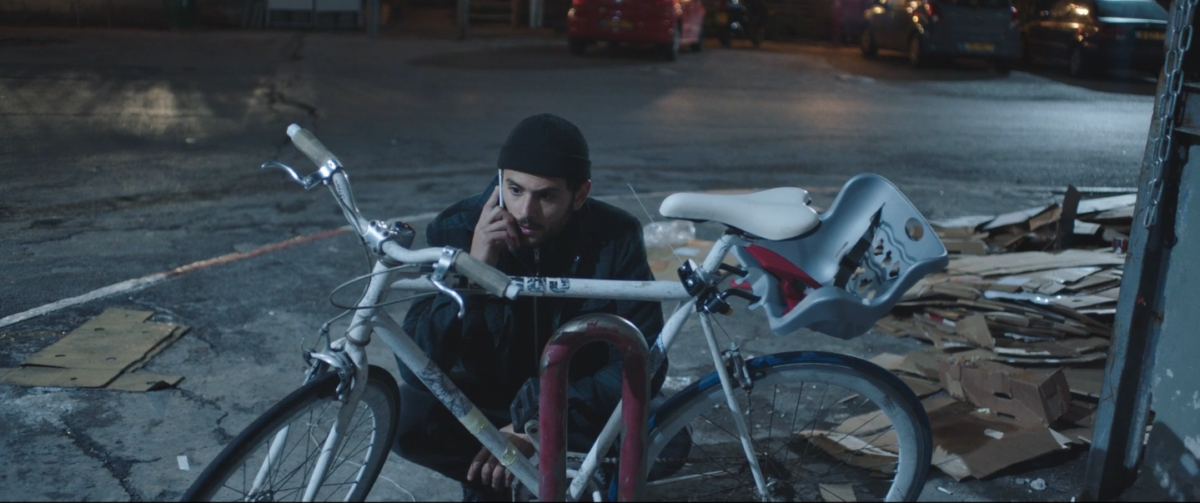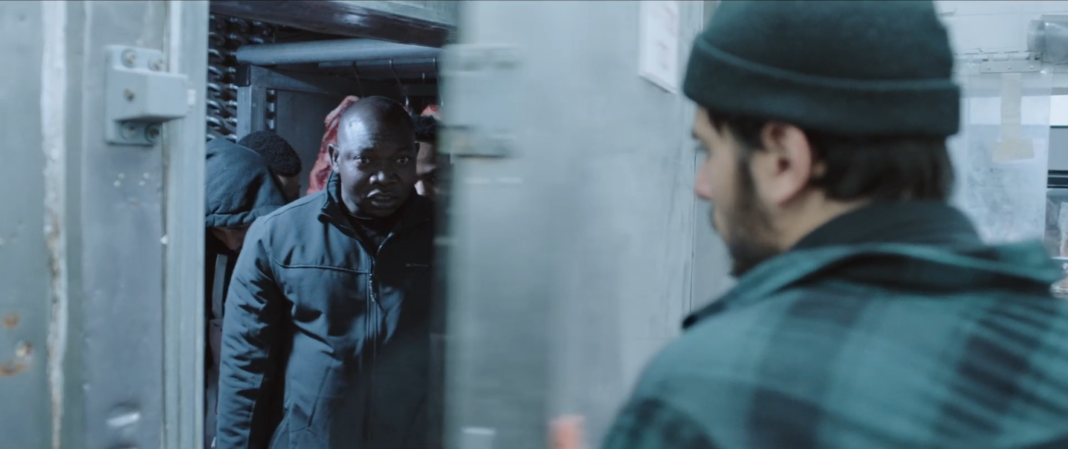Director Tomer Shushan and Producer Shira Hochman heighten the tensions that immigration manifests in a story of anger and misunderstanding in the new Short Film WHITE EYE, a Middle Eastern production that was originally scheduled to play at this year’s South By South West Festival in Austin, Texas.
Film and TV Now recently interviewed the pair as they reflected on the processes and challenges in creating this memorable work.
FILM AND TV NOW: The story is very much a process of consideration and revelation for your lead character when he discovers what he believes to be his bike. How widespread is the issue of illegal immigration in Israel, considering that a lot of people tend to head north to European and British territories?
TOMER SHUSHAN: In the last 10 years, more and more African refugees (mostly from Sudan and Eritrea) have come to Israel to seek asylum.
Most of the people were crossing the land border of Israel and Egypt. This was often seen as a “safer” option as people did not risk their life on small boats crossing the Mediterranean Sea.
By 2018, there were more than 30.000 African migrants, refugees and asylum seekers in our small country. While other parts of the world might have to deal with a higher number of immigrants, the issue stays serious in Israel.
FTVN: The Middle East remains a great source of storytelling in very rural areas and Israel for its rich political and religious history provides a wonderful tapestry for film-makers. What would you say are the key things that make the country unique from other more mainstream-minded industries?
TS: I think a big part is the fusion of Western and Middle Eastern mentality. And by that, I do not only mean the geographical location between Europe and Africa. Israel is home to so many people who have their roots all over the world. The mix of cultures that could not be more different from each other united in one tiny country.. Adding the extreme importance for many religions as well as its historical and archaeological relevance to that creates an energy you cannot compare to any other place.
FTVN: How did you both become film-makers and what was the key decider that made you say that you wanted to express your emotions through visual storytelling?
TS: It was in my early 20’s. After the army service I worked an extremely boring job in the storage of a clothing store. There were only two workers every shift and my favourite one was Yoel. He regularly recommended infamous foreign films of different decades to me. It was almost impossible to find them but if I succeeded I was hypnotized. One film after another, each one was better than the one before.
I remember how much it affected me to discover new stories from different cultures and places. I never thought I could actually do it. Film-making felt bigger and far from me.
But since I started to watch films with so much passion I began to see every moment of my life in a cinematic way. I always imagined how I would shoot a situation and from which angle. Until one day I got a phone with a video camera from my parents. And started to take secret videos of my family and friends. After one year, I decided to study film, since then I feel there is nothing more organic for me then to tell stories with sounds and visuals.
SHIRA HOCHMAN: For me, film and film-making is an act of love and compassion.
My dad loves movies and as a child it was our quality time. I was very excited every time, not from the movie of course but from being with him. He always picked the film to watch, usually it was thrillers, action movies and adventures. I really didn’t care, it was our sacred hours.
I’m making films from a place of great love for the people with whom I create and the necessity of the souls and worlds we create.
FTVN: Tell us about your cast.
TS: It was very important for me that the main actors will meet each other for the first time on the shooting day itself. The body language and the general energy of a very first meeting are really hard to reproduce. So I worked with them separately until I introduced them to each other on set as their characters.
Another main point for me was that the person playing Yunas will not be an actor but an actual African refugee. I wanted this character to be presented by a person with the same background.
After a few months of searching, one night, I walked home at 3 am in the morning. From a dimly lit window of a hamburger place on Rothschild boulevard I saw Dawit, washing dishes. I came close and we looked at each other for a few moments.
Something about his look recognized that someone actually saw him. My first words were “I want you to act in my next film”, he laughed and wouldn’t believe that I’m serious. The day after we met for a coffee and we started our journey. We met twice a week, talking a lot, working on text and body language.
My sister recommended Daniel Gad for the character of Omer.
We met and I just knew. Something about our first meeting was magical. It was the feeling that you wish for while looking for the missing part of a creation.
I didn’t even need to see anything he worked on before.
When we started to develop the character I knew it is important to have Daniel close to me, even outside of the production process as the character is based on me. I decided to take him to Sinai, the best place to spend a quiet time together. We became really close and the work just became much more organic. It was not the director and actor at work, it was two friends trying to tell a story.
FTVN: Tell us about your production team.
SH: Tomer and I got to know each other in 2016 as we worked together on his diploma film – INSIDE SHELLS. We became good friends. It was clear to us that we would continue to work together on his next project.
The production itself was very exciting. Shooting ONE SHOT in one night is definitely challenging. Kobi and I had to prepare for this night very well. It took a lot of rehearsals and meetings.
Each department knew exactly what to do and when. We became a very accurate machine that worked together. We were about 50 people, who wanted to see this shot take place and gave their hearts to the set. The cast and crew from all departments were ALL IN and maintained admirable concentration and patience. A complete set of 50 people is breathtaking for 20 minutes in each take.
So I think that the main part here is having faith, to believe in cinema and in life. All the people that worked on the film believed in it and wanted, deeply in their heart to see it happen and be part of it.
So it’s more about the people you chose to go to this “war” with you.
FTVN: Where did you shoot the film and for how long?
SH: The shooting took place in the south of Tel Aviv, one of the dodgiest places. We had to close three streets for that. We started filming at sunset and finished 11 hours later, with the first ray of light.
FTVN: How did you raise finance for the film?
SH: The biggest part of the cost was raised by the Makor Film Foundation who are supported by the Israeli Ministry of Culture.

FTVN: You are developing a TV series and a feature, TORSO and BETWEEN THE SACRED AND THE SECULAR. Tell us if you can a bit more about both these upcoming projects.
TS: The TV series TORSO is about Leon, a private investigator who was hired by the suspicious wife of a police detective. Instead of discovering the husband’s unfaithfulness, Leon reveals his complex secret. Going deeper and deeper in the trace Leon gets the chance to save the life of innocent people.
My debut feature film is BETWEEN THE SACRED AND THE SECULAR.
It’s a film about an unexpected love story that happens in just one night during a wedding celebration between a waiter and a wealthy wedding guest. Like in “White Eye”, the story deals with the confrontation of two different social classes. The characters are carried into a wild night of passion and pay for it with a threat of their existence.
FTVN: As you were training as film-makers, who were your biggest influences during this period of personal and professional development?
TS: BICYCLE THIEVES (1948) by Vittorio De Sica was the first one on my list to watch and analyse after I decided to make WHITE EYE. The Italian neo realism has always had a lot of influence on me as a filmmaker.
WINTER SLEEP (2014) by Nuri Bilge Ceylan themathises the confrontation of two people with different social status and gave me lots of inspiration to improve my story.
For the technical side and the rhythm of the film I watched VIKTORIA (2014) by Maya Vitkova and IRREVERSIBLE (2002) by Gaspar Noé.
Bela Tarr dominates most of my general inspiration of filmmaking. The mise en scene he creates in his works, especially in THE MAN FROM LONDON, WERCKMEISTER HARMONIES and THE TURIN HORSE, has always had a huge impact on me.
Other directors that have lots of influence on my works are Robert Altman, Spike Jonez, John Cassavetes and Chantal Akerman.
FTVN: Would you be interested in going international and where in the world would you most like to work in the future?
TS: It has always been one of my big motivations to make international films. The ability to reach a bigger audience and touch people of different cultural backgrounds with my work is a dream I am working for very hard.
Even though I take lots of inspiration from film-makers all over the world, I imagine my ideal working environment to be in the United States. In the North American society the movie scene is seen as a key part of the culture and the industry gets a lot of recognition. Besides that I feel that the USA offers many opportunities for young film-makers like myself.
FTVN: What is the Israeli film industry doing to attract more international film-makers and what are the most popular locations to shoot?
SH: There are some opportunities to develop projects through local festivals and film labs such as the well known The Sam Spiegel International Film Lab.
Also, In the last year there is a new tax incentive, which is a tax rebate of 25% that attracts productions from abroad to film in Israel such as the new Netflix series “Hit and Run”.
Israel is a country with beautiful landscapes. Here you can find a wide variety of landscapes and forms ranging from forests, streams and lush mountains in the north to the Dead Sea region and stunning desert views in the south. In addition, since we are a very small country, the locations are within a very short distance of each other.
FTVN: You are keen on sound design in WHITE EYE. Tell us about your collaboration.
TS: Sound is one of my favourite parts to work on during film-making. I think there is barely an aspect that’s more influential to the mood of a scene. Already while writing the script I have a clear vision about how I want the sound to be.
The sound design of WHITE EYE was made by Nin Hacan from D.B. Studios. It was my first time to work with them and I consider myself really lucky to have had such a good dialogue with Nin. He added lots of creativity to the project and the outcome was better than I could ever have dreamed it to be!
FTVN: Finally, what are you most proud of with this short film and what would you like to do next as a subject for a short film?
TS: From the beginning of the project, most of my professional environment tried to convince me not to spend my money and energy on going for a one shot. Everyone thought it would be basically impossible. So I prepared to break the script into shots and cuts, even though inside of me I knew it was not what I wanted.
It was a compromise. After the first shooting day I watched the material and I felt like it was not mine. I cancelled the next shooting days, re-cast most of the crew and figured out an entirely new way to make the film. It took me eight months but I managed to do it. In one shot, with just half of the money.
So I can say I’m very proud of the radical decision that I took that turned out to be the right thing for me and for the film.
For my next project I know that nothing will harm my vision. And that my intuition can beat my fears.





























